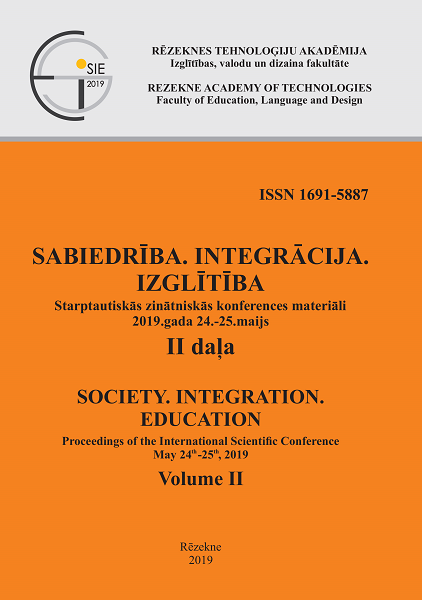ANALYSIS OF METHODOLOGICAL APPROACHES TO PROBLEM SOLVING SKILL IN MATHS TEXTBOOKS FOR GRADES 5-6
DOI:
https://doi.org/10.17770/sie2019vol2.3852Keywords:
methodological approaches, problem solving skill in mathematics, textbook analyzeAbstract
One of the most important cross-cutting skills in the competence approach, which is developed in learning mathematics, is problem-solving. Solving mathematics word problems with practical content includes both text analysis, visualization of content, planning, and searching for different solution steps, argumentation of one’s opinion, solution design, as well as research. During his working life Professor J. Mencis (senior) has developed a methodological system of word problems. What is the offer of other authors? The aim of the article is to analyse the implementation of methodological approaches by various authors in the 5-6th grade maths textbooks, which develop the problem-solving skill, in order to find out the strengths and weaknesses of these methodological solution.Downloads
References
Ausējs, L. (1935). Aritmētikas metodika. Rīga: Rīgas skolotāju institūta bijušo audzēkņu biedrība.
Boonen, A. J. H., Van Der Schoot, M., Van Wesel, F., De Vries, M. H., & Jolles, J. (2013). What underlies successful word problem solving? A path analysis in sixth grade students. Contemporary Educational Psychology, 38, 271-279. Retrieved from: http://static.jellejolles.nl/Boonen-et-al.-2013-What-underlies-successful-word-problem-solving-A-path-analysis-in-sixth-grade-students.pdf
Geske, A., Grīnfelds, A., Kangro, A., & Kiseļova, R. (2013). Latvija OECD Starptautiskajā skolēnu novērtēšanas programmā 2012 – pirmie rezultāti un secinājumi. Rīga: LU. Pieejams: https://www.ipi.lu.lv/fileadmin/_migrated/content_uploads/Latvija_SSNP_2012_pirmie_rezultati_un_secinajumi.pdf
Geske, A., Grīnfelds, A., Kangro, A. & Kiseļova, R. (2016). Latvija OECD Starptautiskajā skolēnu novērtēšanas programmā 2015 – pirmie rezultāti un secinājumi. Rīga: LU. Pieejams: http://www.izm.gov.lv/images/statistika/petijumi/Gramata2015.pdf
Hegarty, M., & Kozhevnikov, M. (1999). Types of visual–spatial representations and mathematical problem solving. Journal of Educational Psychology. 91, 684-689. Retrieved from: http://www.nmr.mgh.harvard.edu/mkozhevnlab/wp-content/uploads/pdfs/types_visual1999.pdf
Jiménez, L., & Verschaffel, L. (2013). Development of Children’s Solutions of Non-Standard Arithmetic Word Problem Solving /El desarrollo de las soluciones infantiles en la resolución de problemas aritméticos no estándar. Revista de Psicodidactica / Journal of Psychodidactics, 19(1), 93–123. DOI: https://doi.org/10.1387/RevPsicodidact.7865
Johansson, M. (2006). Teaching mathematics with textbooks: a classroom and curricular perspective. Doctoral dissertation, Luleå University of Technology. Retrieved from: https://www.diva-portal.org/smash/get/diva2:998959/FULLTEXT01.pdf
Krastiņa, E., Sondore, A., & Drelinga, E. (2015). How to promote text comprehension with pupils of grades 1–6 when teaching to solve combinatorial problems. Acta Paedagogica Vilnensia, 35(35), 67–80. Retrieved from: https://www.ceeol.com/search/article-detail?id=524776
Lepik, M. (2015). Analyzing the use of textbook in mathematics education: the case of Estonia. Acta Paedagogica Vilnensia, 35(35), 90–102. Retrieved from: http://www.journals.vu.lt/acta-paedagogica-vilnensia/article/view/9193
Lepik, M., Grevholm, B., & Viholainen, A. (2015). Using textbooks in the mathematics classroom-the teachers’ view. Nordic Studies in Mathematics Education, 20(2–3), 129–156. Retrieved from:
Mencis, J. (1993). Matemātikas mācīšanas metodiskā sistēma pamatskolā. Profesors Jānis Mencis (1914 - 2011). Bibliogrāfija. Liepāja: LiepU.
Mencis, J. (2014). Matemātikas metodika pamatskolā. Rīga: Zvaigzne ABC
Mitčenko, O., & Rozenfelde, M. (2014). Teksta uzdevumu risināšanas prasmju attīstīšana 5.-6. klases skolēniem ar mācīšanās traucējumiem. Education Reform in Comprehensive School: Education Content ResearcH & Implementation Problems. Pieejams: journals.rta.lv/index.php/PSPI/article/download/1128/1213
NCTM. (2000). Principles and Standards for School Mathematics. The National Council of Teachers of Mathematics, Portland: Inc. Graphic Art Center
Pepin, B., & Haggarty, L. (2001). Mathematics textbooks and their use in English, French and German classrooms. Zentralblatt für Didaktik der Mathematik, 33(5), 158–175. Retrieved from: https://link.springer.com/article/10.1007/BF02656616
Pipere, A. (2011). Datu analīze kvalitatīvajā pētījumā. No K. Martinsone (sast.) Ievads pētniecībā: stratēģijas, dizaini, metodes (220–243). Rīga: RaKa.
Robitaille, D.F., & Travers, K.J. (1992). International studies of achievement in mathematics. In D. A. Grouws (Ed.), Handbook of research on mathematics teaching and learning: A project of the National Council of Teachers of Mathematics (687-709). New York, NY, England: Macmillan Publishing Co, Inc. Retrieved from: https://psycnet.apa.org/record/1992-97586-027
SKOLA 2030. (2017). Izglītība mūsdienīgai lietpratībai: mācību satura un pieejas apraksts. Pieejams http://www.izm.gov.lv/images/aktualitates/2017/Skola2030Dokuments.pdf
Sondore, A., Krastiņa, E., Drelinga, E., & Daugulis, P. (2017). Improving mathematical competence in primary school to enable skill transfers in new situations. Proceedings of the International Scientific Conference "Society.Integration.Education", Volume II, 208-218.
VISC. (2016, 2017, 2018). Vispārējā izglītība. Pārbaudes darbi. Pieejams: https://visc.gov.lv/vispizglitiba/eksameni/info.shtml
Vītuma, M., & Krastiņa, E. (2014). Diagnosticējošais darbs matemātikā 6.klasei 2013./2014. mācību gadā: rezultātu analīze un ieteikumi. Pieejams: https://visc.gov.lv/vispizglitiba/eksameni/dokumenti/metmat/2013_2014_ddarbs_matem_6kl_met_mat.pdf
Демидова, Т. Е., & Тонких, А. П. (2002). Теория и практика решения текстовых задач. Москва: ИЦ" Академия".
Пойа, Д. (1959). Как решать задачу. Москва: Государственное учебно-педагогическое издательство министерства просвещения РСФСР. Retrieved from: http://www.vixri.com/d/P%20O%20J%20A%20D.%20%20_KAK%20REShAT'%20ZADAChU.pdf
Стойлова, Л. П. (1997). Математика: учеб. пособие для студ. сред. пед. учеб. заведений (2-e изд.). Москва: Академия.
Фридман, Л. М. (2002). Сюжетные задачи по математике. История, теория, методика: учеб. пособие для учителей и студентов педвузов и колледжей. Москва: Школьная пресса.
Царева, Е. С. (1998). Обучение решению текстовых задач, ориентированное. Новосибирск: НГПУ.
Шелехова, Л. B. (2007). Обучение решению сюжетных задач по математике. Майкоп. Retrieved from: http://window.edu.ru/catalog/pdf2txt/685/72685/50207


